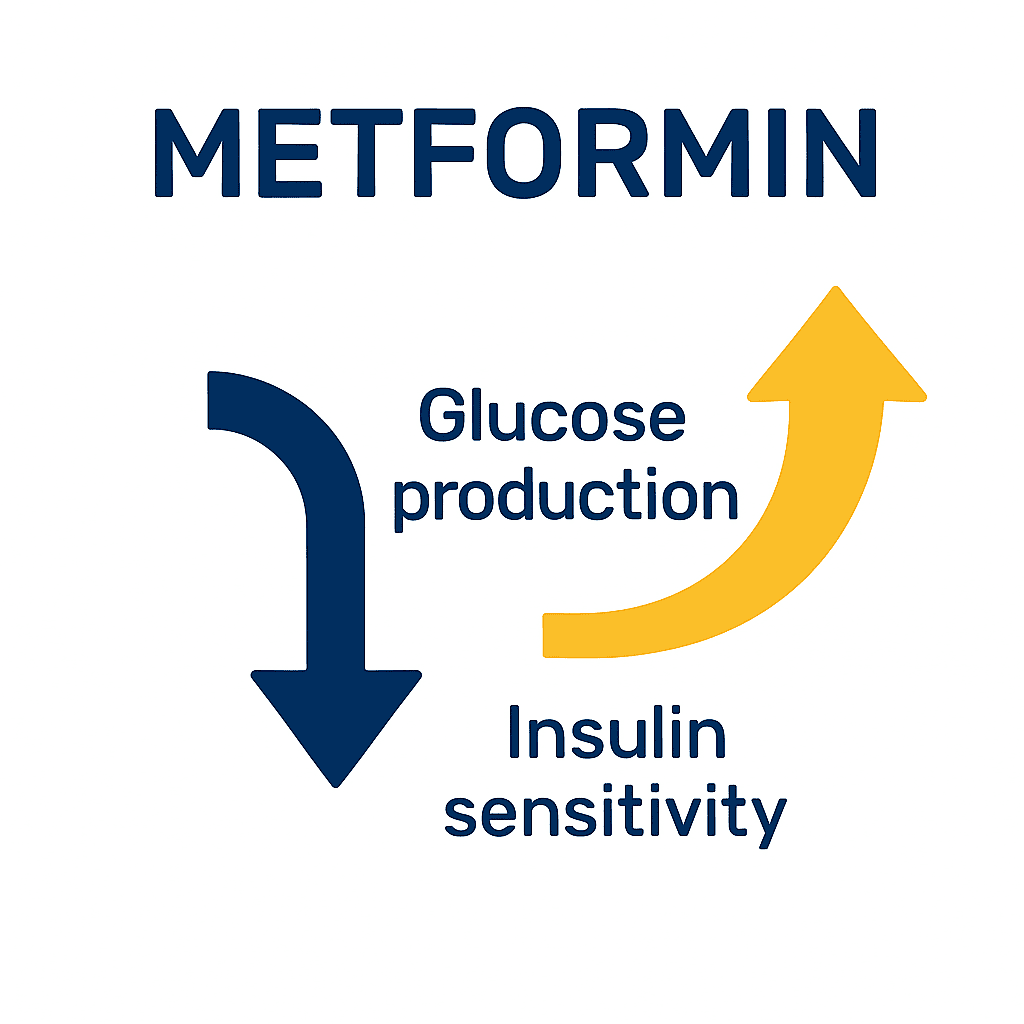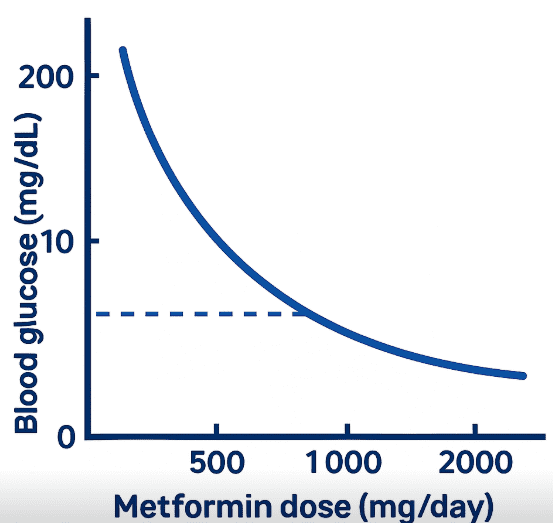Metformin is one of the most widely used and well-studied medications for the management of type 2 diabetes mellitus (T2DM). It belongs to the biguanide class of drugs and has been a cornerstone of diabetes therapy for decades.
Its popularity stems from its proven efficacy, safety profile, and cardiometabolic benefits — making it the first-line pharmacological treatment for most patients with type 2 diabetes.
🔬 Mechanism of Action of Metformin
Metformin works primarily by reducing hepatic glucose production (gluconeogenesis). It also:
Increases insulin sensitivity in peripheral tissues (especially muscles)
Enhances glucose uptake and utilization
Decreases intestinal absorption of glucose
Unlike some other antidiabetic drugs, metformin does not cause hypoglycemia when used alone because it does not stimulate insulin secretion.

⚕️ Indications
Metformin is indicated for:
Type 2 Diabetes Mellitus (T2DM) – as monotherapy or in combination with other antidiabetic agents.
Prediabetes – to delay or prevent progression to diabetes, especially in overweight individuals.
Polycystic Ovary Syndrome (PCOS) – used off-label to improve insulin sensitivity and restore ovulation.
Insulin Resistance and Metabolic Syndrome – sometimes prescribed for metabolic control.
💊 Dosage and Administration of Metformin
| Formulation | Starting Dose | Usual Maintenance | Maximum Daily Dose | Notes |
|---|---|---|---|---|
| Immediate-release (IR) | 500 mg once daily (with meal) | 1500–2000 mg in divided doses | 2550 mg/day | Titrate gradually to reduce GI upset |
| Extended-release (XR) | 500 mg once daily (evening) | 1000–2000 mg once daily | 2000 mg/day | Better GI tolerability |
🩺 Always take Metformin with food to reduce gastrointestinal side effects.
Dose adjustments may be needed for renal impairment.

Blood glucose vs. Metformin dose graph
⚠️ Contraindications
Metformin should not be used in patients with:
Severe renal impairment (eGFR < 30 mL/min/1.73 m²)
Acute or chronic metabolic acidosis (including diabetic ketoacidosis)
Severe hepatic impairment
Conditions associated with hypoxia (e.g. heart failure, respiratory failure, shock)
Before and after iodinated contrast studies — temporarily discontinue to avoid lactic acidosis risk
💢 Adverse Effects
Common side effects:
Gastrointestinal symptoms – nausea, vomiting, diarrhea, abdominal pain
Metallic taste in the mouth
Loss of appetite
Serious but rare:
Lactic acidosis – risk increased in renal, hepatic, or hypoxic conditions
Vitamin B12 deficiency with long-term use (monitor levels annually)
⚙️ Precautions
Monitor renal function before and during therapy.
Avoid excessive alcohol consumption (increases risk of lactic acidosis).
In long-term therapy, monitor vitamin B12.
Pause treatment if undergoing surgery, contrast imaging, or any serious illness causing dehydration.
❤️ Benefits Beyond Glucose Control
Modest weight reduction
Reduction in LDL cholesterol and triglycerides
Cardioprotective effects
Potential anti-cancer and longevity effects (still under investigation)
| Feature | Details |
|---|---|
| Drug Class | Biguanide |
| Mechanism | ↓ hepatic glucose production, ↑ insulin sensitivity |
| Main Use | Type 2 Diabetes Mellitus |
| Common Side Effects | GI upset, metallic taste |
| Serious Risk | Lactic acidosis |
| Contraindications | Severe renal/liver disease, hypoxia |
| Monitoring | Renal function, Vitamin B12 level |
🧠 Quick FAQs
Q1. Can metformin cause hypoglycemia?
→ No, not when used alone. It doesn’t stimulate insulin secretion.
Q2. Can metformin be used during pregnancy?
→ Sometimes used under medical supervision, particularly in gestational diabetes or PCOS.
Q3. How long does metformin take to work?
→ Some glucose-lowering effect appears within days, but full effect may take 1–2 weeks.
Q4. Can metformin cause weight loss?
→ It may promote mild weight reduction due to improved insulin sensitivity and appetite control.
Q5. Is metformin safe for kidneys?
→ Safe if kidney function (eGFR ≥ 45) is normal; avoid or reduce dose if eGFR < 45.
🧭 Conclusion
Metformin remains the first-line antidiabetic drug because of its efficacy, safety, and long-term cardiovascular benefits.
Understanding its mechanism, dosing, and contraindications ensures safe and effective patient care.
Whether you are a healthcare professional, student, or patient, knowing how and when to use metformin is essential for managing diabetes safely and successfully.





